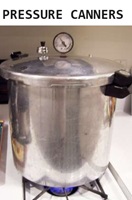
Looking for How to can your own mangoes (complete directions with photos) in 2025? Scroll down this page and follow the links. And if you bring home some fruit or vegetables and want to can, freeze, make jam, salsa or pickles, see this page for simple, reliable, illustrated canning, freezing or preserving directions. There are plenty of other related resources, click on the resources dropdown above. If you are having a hard time finding canning lids, I've used these, and they're a great price & ship in 2 days.
If you have questions or feedback, please let me know! There are affiliate links on this page. Read our disclosure policy to learn more.
How to can your own mangoes (complete directions with photos)
Mangoes - Where to get them, how to use them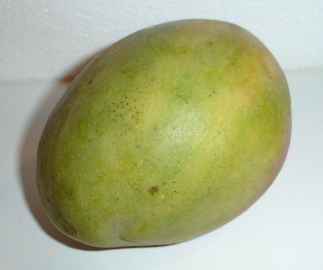
Mangoes are a sweet tropical fruit, with a texture like a ripe peach, and
a musky scent.
Mangoes are usually picked and shipped for the commercial market while
still green. Most mature from May to September, the largest harvest is in
June and July. The fruit of each variety develops to different sizes and
growers usually wait for a 'filling out' of the fruit to a certain size,
before picking. Unripe mangoes are usually green, but could have a reddish
tinge near the stem area.
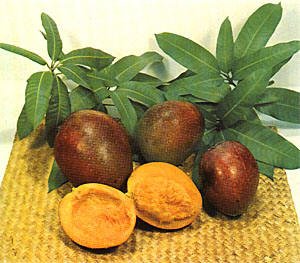 When
selecting unripe mangoes for a recipe, choose fruit that are green and
uniformly hard, with no skin blemishes.
When
selecting unripe mangoes for a recipe, choose fruit that are green and
uniformly hard, with no skin blemishes.
The fruit is best stored for
ripening between 70-75°F (but not below 50°C), which occurs within 3-8 days.
Ripe mangoes should be firm to the touch, but should slightly yield to
pressure. The skin should be tight, and could have areas of green, yellow
and red/orange, but should not be wrinkled.
Wrinkly, soft fruit are overripe. The flesh of a ready-to-eat mango
should be golden yellow/orange and may or may not have fibers. Low-fiber
varieties may be preferred for eating or for use in recipes.
Mangoes, like many sweet stone or
pitted fruit, can be packed in very light, light or medium sugar syrup. They can
also be packed in water, apple juice or white grape juice.
You can preserve your own mangoes by canning them. Prepared this way, the jars have a shelf life of about 12 to 18 months, and aside from storing in a cool, dark place, require no special attention. If you'd rather freeze your fruit, see my page on How to freeze mangos. You can freeze mangoes just like peaches. Even easier than canning and they will taste just like fresh.. but it does take up space in the freezer.
You may also be interested in How to make GREAT mango chutney! and How to make mango salsa. and Mango-raspberry jam
Selecting Mangoes
Choose ripe, mature fruit of ideal quality for eating fresh or cooking. They should not be mushy, but they also should not be rock hard: just as ripe as you would eat them fresh. You can also use solid green mangoes. Select firm, non-fibrous fruit. Caution: Handling green mangoes may irritate the skin of some people in the same way as poison ivy. (They belong to the same plant family.) (see this page for more information) To avoid this reaction, wear plastic gloves while working with raw green mango. Do not touch your face, lips or eyes after touching or cutting green mangoes until all traces are washed away .
Where to get mangoes
Most mangoes sold in the U.S. are imported from Mexico, Brazil and Central America, though some are grown in California and Florida. These are mainly of the South-East Asian (Indo Chinese) type, originating in the Philippines and may be 2-9 inches long. Varieties usually available in grocery stores are
- Tommy Atkins (commercial Florida variety, medium to large thick-skinned fruit, orange-yellow with red or purple areas, medium fiber),
- Haden (Indian type, mild flavor, low fiber, oval, yellowish-red fruit),
- Kent (large fruit, greenish-yellow with red areas near stem, no fiber) and
- Keitt (large green fruit with little fiber).
If you live in Florida or California, you can buy some locally, but I am not aware of any pick-your-own mango farms. Of course, you can buy them at the grocery store in the summer months. But for large quantities, you will find that Costco, Sam's Club and BJ's seem to have the largest mangoes and best prices.
It takes about 5 good sized mangoes to fill one quart jar.
Peeling Mangoes
Nope, we're not going to peel them strictly by hand; that's way too much work. Instead, here's a great trick that works with many fruits and vegetables with skins (like tomatoes): just dip the fruit in boiling water for 60 seconds. Remove from the water using a slotted spoon and put into a large bowl or pot of cold water and ice. The skins will easily peel off more easily now!
Also, mangoes are also MUCH easier to peel when slightly ripe.
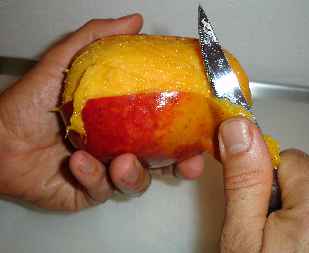
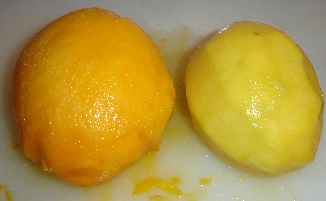
Cutting up mangoes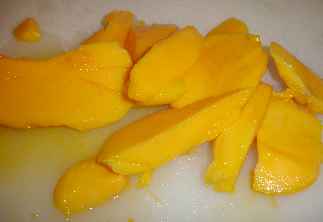
Cut out any brown spots and mushy areas.
See here for related tools, equipment, supplies on Amazon This mango splitter works great!
Preventing cut mangoes from darkening!
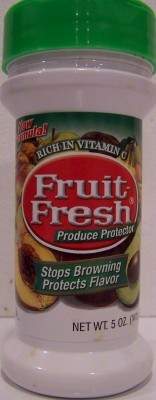 Now,
to keep the fruit from turning brown, when you get a bowlful, sprinkle
1/4 cup lemon juice or Fruit-Fresh (which is just a mix of citric acid
and vitamin C, perfectly natural). Then stir the mangoes to make
sure all the surfaces have been coated.
Now,
to keep the fruit from turning brown, when you get a bowlful, sprinkle
1/4 cup lemon juice or Fruit-Fresh (which is just a mix of citric acid
and vitamin C, perfectly natural). Then stir the mangoes to make
sure all the surfaces have been coated.
Mango Nutrition Facts
From the USDA
| Nutritional value per 100 g (3.5 oz) | |
|---|---|
| Energy | 250 kJ (60 kcal) |
|
15 g
|
|
| Sugars | 13.7 |
| Dietary fiber | 1.6 g |
|
0.38 g
|
|
|
0.82 g
|
|
| Vitamins | |
| Vitamin A equiv. |
(7%)
54 μg
(6%)
640 μg
23 μg
|
| Thiamine |
(2%)
0.028 mg |
| Riboflavin |
(3%)
0.038 mg |
| Niacin |
(4%)
0.669 mg |
|
(4%)
0.197 mg |
|
| Vitamin B |
(9%)
0.119 mg |
| Folate &URL=http%3A%2F%2Fen.wikipedia.org/wiki/Pantothenic_acid"> Pantothenic acid |
(4%)
0.197 mg |
| Vitamin B |
(9%)
0.119 mg |
| Folate |
(11%)
43 μg |
| Choline |
(2%)
7.6 mg |
| Vitamin C |
(44%)
36.4 mg |
| Vitamin E |
(6%)
0.9 mg |
| Vitamin K |
(4%)
4.2 μg |
| Trace metals | |
| Calcium |
(1%)
11 mg |
| Iron |
(1%)
0.16 mg |
| Magnesium |
(3%)
10 mg |
| Manganese |
(3%)
0.063 mg |
| Phosphorus |
(2%)
14 mg |
| Potassium |
(4%)
168 mg |
| Sodium |
(0%)
1 mg |
| Zinc |
(1%)
0.09 mg |
Looking for canning equipment and supplies?
Water bath canner with a jar rack
Pressure canners for gas, electric and induction stoves: Presto 23Qt or T-fal 22Qt
Canning scoop (this one is PERFECT)
Ball Blue book (most recent version)
Jars: 8oz canning jars for jams
Find Other types of farms:
Farm markets and roadside stands
Road trips and camping resources
Local Honey, apiaries, beekeepers
Consumer fraud and scams information
Home canning supplies at the best prices on the internet!
Maple Syrup Farms, sugarworks, maple syrup festivals
Environmental information and resources
Farms For Your Event for birthday parties, weddings, receptions, business meetings, retreats, etc.
Festivals - local fruit and vegetable festivals
Get the
most recent version of
the Ball Blue Book
With this Presto 23 quart pressure canner and pressure cooker, you can "can" everything, fruits, vegetables, jams, jellies, salsa, applesauce, pickles, even meats, soups, stews. Model 01781
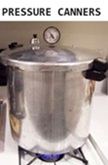
You can make jams, jellies, can fruit, applesauce, salsa and pickles with water bath canners, like this Granite Ware 12-Piece Canner Kit, Jar Rack, Blancher, Colander and 5 piece Canning Tool Set

